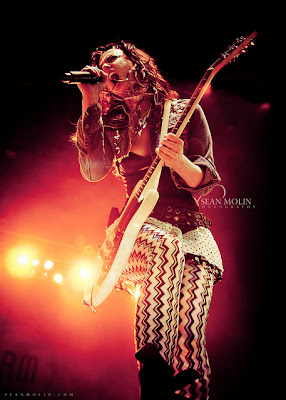Gig photography or concert photography is one genre of photography that has gained much publicity in the recent years. With the dawn of the digital age, the number of people photographing concerts has gone sky rocketing. Nearly everyone at any concert now carries a digital camera. And as a result nowadays there are restrictions on bringing and using camera on concert locations.
 |
| Photo By Sean Molin |
Taking good photographs during concerts is a tricky business. Most of the time you are faced with low light levels, changing light colours and brightness, you are in a no flash zone, and to top all that you are in the midst of a huge crowd, jumping, swaying, pushing, pulling etc.
Let us discuss certain points that will help you take better photos during concerts.
Camera Settings for Gig Photography.
To start with, don’t go to concerts with a point and shoot. You need to have a DSLR.
Put on the fastest lens you own. If you don’t own any fast lens, it is advisable to go get a 50mm (f/1.8) prime, both canon and Nikon makes them around $100 range. Don’t be deceived by the price, they are among the best lens ever made.
Change your file type to RAW. Even though it will take more space in your memory card, you will thank yourselves for doing so while post processing.
Use the AWB (Automatic White Balance) mode. Since you are shooting in RAW you need not concern about white balance any more.
Use spot metering mode, as different light levels present in the scene will often trick the camera into either under exposing or over exposing your main subject if in evaluative or other metering modes.
Get your exposure right. As you will be mostly using the widest aperture your lens permits, what determines exposure now will be shutter speed. You might be forced to increase your ISO to get any decent shutter speed to shoot hand-held.
A full frame camera is always preferable for Gig photography over cameras with crop sensors, due to their reduced noise levels at high ISO.
Use your histogram to make sure you have your exposure right. The small LCD screen on your camera may not always show you accurate results.
Put your camera in Multi shot mode and click in bursts, this way you have better chance of getting more sharp pictures.
 |
| Photo By Hani Amir |
Tips for Gig Photography
Arrive early at the scene, this gives you plenty of time to hang out around the place and find out good positions to shoot from, if possible have conversation and make friends with the band or security people.
While shooting concerts always check for foreground and background clutter, as these may render a perfect shot worthless. It is a difficult thing to get clean foreground and backgrounds during concerts, you may have to shift your position, shoot from a different angle, try rendering background out of focus etc to tackle the problem.
Try to capture mood and movement present in the scene. Capture the expressions, emotions, mannerisms etc of the performers, and also capture the reactions of the crowd.
 |
| Photo By Hani Amir |
Add an amount of creativity, time your shots with light changes, capturing interestingly lit frames, use ultra wide angle lens to induce distortion, try shooting from low angles, include the lights in your frame etc.
Get close or use a telephoto zoom lens to capture the little details, the artists guitar, his or her ornaments, the way the drummer holds the sticks etc.
Get close or use a telephoto zoom lens to capture the little details, the artists guitar, his or her ornaments, the way the drummer holds the sticks etc.
 |
| Photo By luigioss |
And finally remember to have fun on location, you aim should be to have a good time and get some good shots in the process. Relax and enjoy the show and don’t get discouraged if you do not get what you expected. This is one genre of photography that is hard to master. You will sure succeed next time.
In the next article we will discuss about Photography - Types of Light - Continuous Light
Post a Comment